You are using an out of date browser. It may not display this or other websites correctly.
You should upgrade or use an alternative browser.
You should upgrade or use an alternative browser.
Hello - Newbie from Scotland
- Thread starter PMP
- Start date

Help Support UKworkshop.co.uk:
This site may earn a commission from merchant affiliate
links, including eBay, Amazon, and others.
Robbo3
Established Member
Not sure if anyone has said, but get a copy of Keith Rowley - Woodturning A Foundation Coarse. 84p + £2.79 p & p) from
- https://www.alibris.co.uk/booksearch?ke ... 29&hs.y=28
You are getting tear out from either having blunt tools, taking too big a cut or cutting uphill. With spindle work we always cut downhill ie from outside towards the centre.
Have a days tuition with a professional. That will give you the basics of technique & how to sharpen your tools. Try & find a local club to join.
If you can't do either, get the book & just keep making shavings. You'll find out what works & what doesn't. Most of all, enjoy.
- https://www.alibris.co.uk/booksearch?ke ... 29&hs.y=28
You are getting tear out from either having blunt tools, taking too big a cut or cutting uphill. With spindle work we always cut downhill ie from outside towards the centre.
Have a days tuition with a professional. That will give you the basics of technique & how to sharpen your tools. Try & find a local club to join.
If you can't do either, get the book & just keep making shavings. You'll find out what works & what doesn't. Most of all, enjoy.
Trevanion
Greatest Of All Time
You never see it recommended, but I think "Modern Woodturning" by Gordon Stokes is an excellent book for a beginner. You can tell its written by a master because of all the very firm "YOU MUST NOT" about bad practice described in the book :lol: You can pick it up for pence off Abebooks or eBay. I happened across a signed copy from the man himself dated 1975, with some pieces of paper with some detailing which I have yet to deciper in it.
PMP
Established Member
Robbo3":24gxnbsi said:Not sure if anyone has said, but get a copy of Keith Rowley - Woodturning A Foundation Coarse. 84p + £2.79 p & p) from
- https://www.alibris.co.uk/booksearch?ke ... 29&hs.y=28
You are getting tear out from either having blunt tools, taking too big a cut or cutting uphill. With spindle work we always cut downhill ie from outside towards the centre.
Have a days tuition with a professional. That will give you the basics of technique & how to sharpen your tools. Try & find a local club to join.
If you can't do either, get the book & just keep making shavings. You'll find out what works & what doesn't. Most of all, enjoy.
Hi Robbo, thanks for the tips
I do have the Woodturning: A foundation course : one i got had a dvd which was very informative.
I do try and follow the good practice in the book and so far most of the catches have been either from a mistake i knew i made straight after i did it, i.e. saw what i did wrong, or i am using the tool in an improper way, i.e. the round edge scraper in too tight a space.
The good thing about the cheap cuts is, it costs nothing to make these learning mistakes so can get better before trying something nicer.
The main one i did was with the parting tool and i think it was too blunt and also i came in at it with the tool point facing upwards and presenting it to the turning wood, when it seems to work safer and better when i present the point at a horizontal angle to the turning face.
Took a morning to play about with my sharpening jig after watching some more videos online and got much better results with a single bevel angle with no facets on the fingernail profiles
lurker
Le dullard de la commune
I would suggest the lathe could be quite dangerous if you do not bolt it down to the bench.
At best it will vibrate / move so much you will never get anything made.
At best it will vibrate / move so much you will never get anything made.
PMP
Established Member
I have thought about that too, a bit more involved as the lathe has no mounting points, so will need brackets made and holes drilled into the iron base of the bed. not massively difficult, just a bit more involved.
Dave Brookes
Established Member
Not trying to be a “smart ar*e” but have you looked under the feet for tapped holes to bolt it down from?
Dave
Dave
Robbo3
Established Member
PMP":1a3whlt6 said:..... so far most of the catches have been either from a mistake i knew i made straight after i did it, i.e. saw what i did wrong, or i am using the tool in an improper way, i.e. the round edge scraper in too tight a space.
The good thing about the cheap cuts is, it costs nothing to make these learning mistakes so can get better before trying something nicer.
The main one i did was with the parting tool and i think it was too blunt and also i came in at it with the tool point facing upwards and presenting it to the turning wood, when it seems to work safer and better when i present the point at a horizontal angle to the turning face.
Took a morning to play about with my sharpening jig after watching some more videos online and got much better results with a single bevel angle with no facets on the fingernail profiles
That's good. If you can analyse what went wrong it's much easier to not make the same mistake again.
I quite agree about cheap, or better still, free wood. I quite often use logs from the firewood pile to practice on.
Well done with the sharpening. Now that you have got it right with the gouge(s) what you require is consistency so as not to waste metal ie same jig angle, same gouge protrusion & same pivot point distance from the wheel.
PMP
Established Member
Dave Brookes":c66elbzo said:Not trying to be a “smart ar*e” but have you looked under the feet for tapped holes to bolt it down from?
Dave
Yeah i had a look when i took the lathe apart for a clean\service as it had sat for over a year before being in a position to use it and apart from being quite heavy cast iron, the base just has right angle ends that sit on the thin profile (If you see what i mean), no flat sections to sit on that i could drill through, will need some "L" plates made up.
Not hard, but feel adding in some casted mounting points would have been a basic design requirement.
When you do bolt it down it'll pay you to get it as close to the front of the bench as you can. You'll find it back breaking where it is.
PMP
Established Member
And it was all going so well....
I finally got the lathe bolted down over the weekend, what with my wife bing 7 months pregnant now and being busy last few months with commissions and a rather unfortunate event where for an unknown reason my body decided that it didnt want to be upright and promptly passed out while in the loo early one morning, properly faceplanted onto the stone tiled floor, bit through my lip and wife called ambulance, which is what you want at 5am. fortunately nothing wrong, just seen as either low blood pressure from early AM just stabding up, or it can happen when you go for morning loo visit!!
So decided not to operate sharp tools and high speed machinery for a bit.
First quiet day for a bit between commissions so i started playing about with some new techniques, and...it didnt go well.
I wanted to try and make a small goblet going by the instructions in Keith Rowleys book, mainly hollowing out on spare blocks to get a feel for it, and after 3 attempts i was about ready to set my shed on fire.
I did secure my lathe down to the desk:
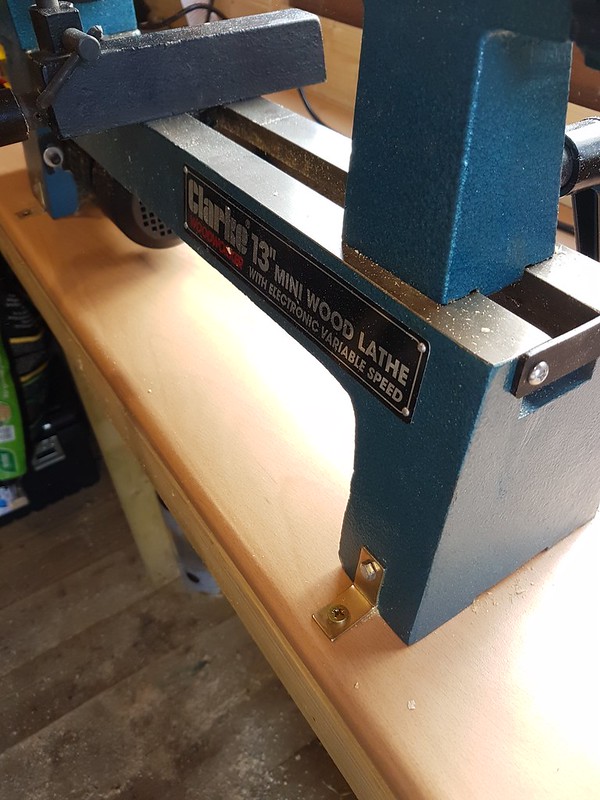 20190923_122057 by Richard Rose, on Flickr
20190923_122057 by Richard Rose, on Flickr
First failure was my own fault and i knew what happened, using a small 3/8" spindle gouge i was carefully removing material but after a bit i think the trailing edge of the profile caught the side wall at the edge and the piece working on came right off the machine, i think the scroll chuck doesnt grip strongly enough and pieces can move out under jerks\catches.
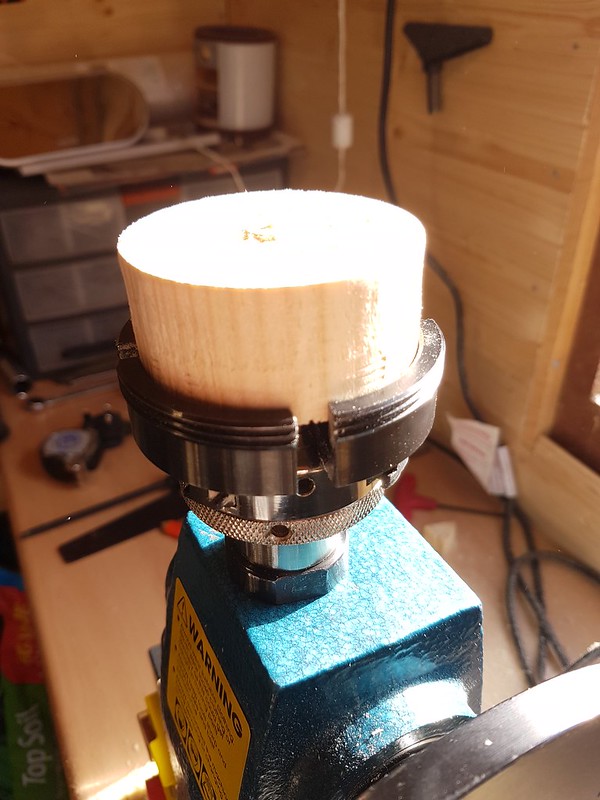 20190923_121639 by Richard Rose, on Flickr
20190923_121639 by Richard Rose, on Flickr
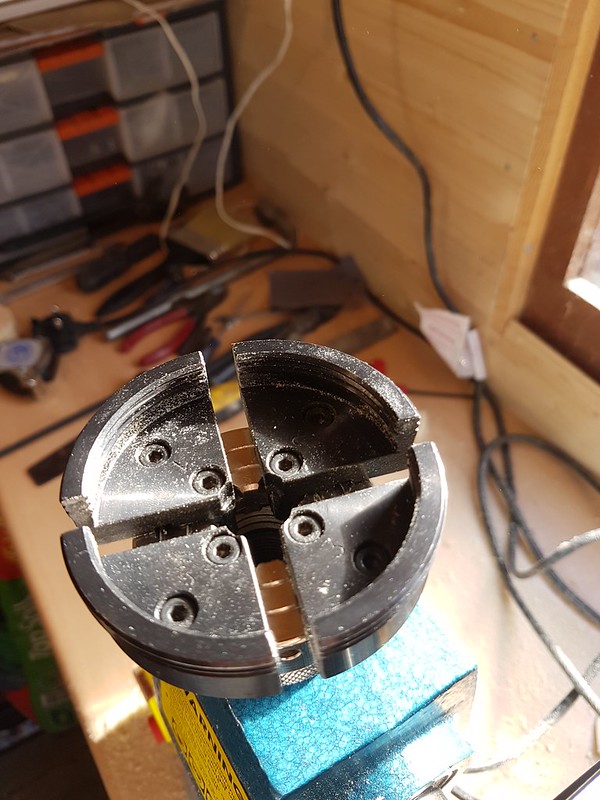 20190923_121628 by Richard Rose, on Flickr GONE!
20190923_121628 by Richard Rose, on Flickr GONE!
So i cut off the waste and made another attempt, this time using my 3/8" bowl gouge, which i made into a more high winged grind from the standard factory setup. This i was being very cagey with as its a bigger tool (diamater of the tool compared with the spindle gouge) and i was wary of digging in and parts flying!
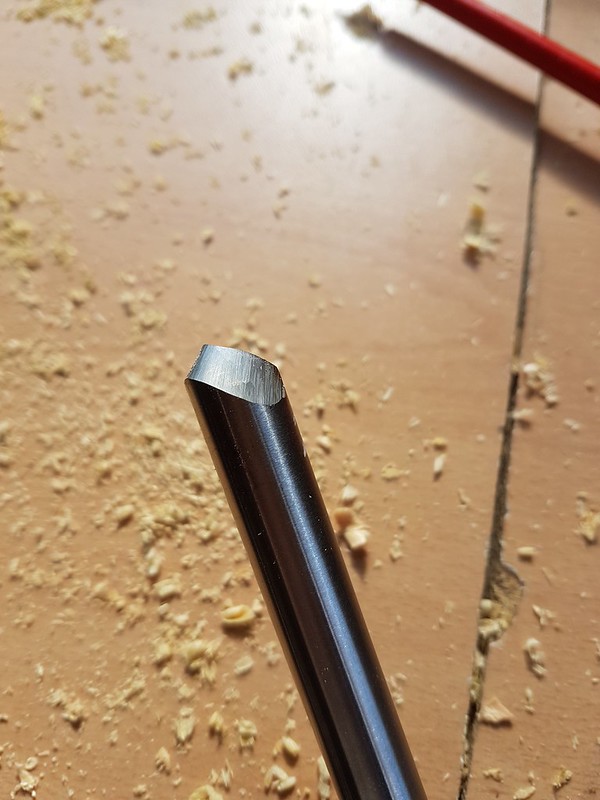 20190923_121508 by Richard Rose, on Flickr
20190923_121508 by Richard Rose, on Flickr
This time i screwed the wood onto the faceplate to get a stronger hold for working. The tool was working okay, i was making sure not to present at 90' to the tool rest and make sure the lower left of the cutting edge from the tip was cutting and not the wing so moving the tool handle away from my as i came up the side wall while hollowing (if that makes sense).
However after a bit it must have caught again and the whole thing (only a cylinder about 4" long and 3" wide so nothing big!) ripped off the faceplate and at that point i gave it up as a bad job.
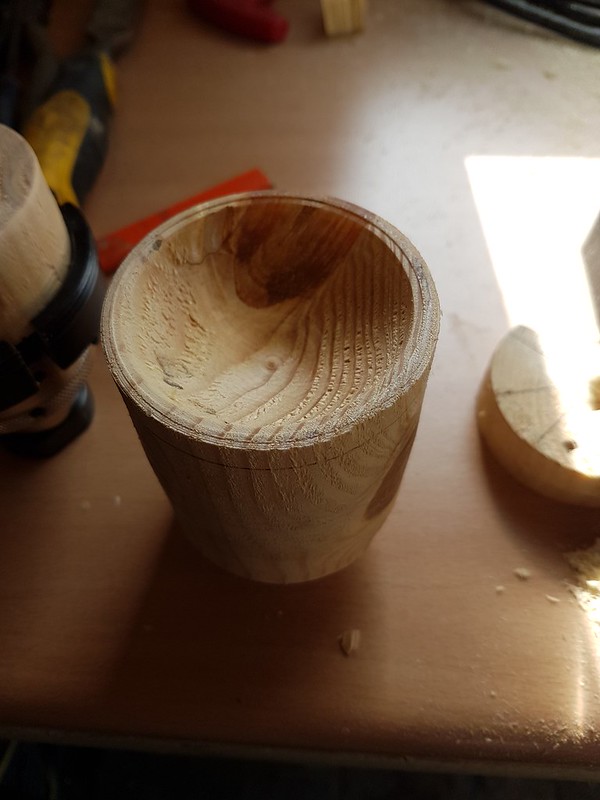 20190923_121652 by Richard Rose, on Flickr
20190923_121652 by Richard Rose, on Flickr
 20190923_121658 by Richard Rose, on Flickr
20190923_121658 by Richard Rose, on Flickr
Examples of the drama:
The main issue i have is, there isnt any local turning groups around here (nearest is about an hour away) and yout tube vids and reading can only show you so much.
I realise this is only my first attempts at hollowing, but for both time to result in cathcing and rippping the wood from the lathe, its not filling me with confidence.
On the plus side, i was able to turn out a sharper looking new type of xmas tree using the scroll chuck jaws holding the piece and parted it off safely with parting tool so not all bad.
so not all bad.
I will keep working away and maybe the smaller diameter hollowing out is actually harder than a bowl blank that has more space to work and less acute angles. Dunno
I finally got the lathe bolted down over the weekend, what with my wife bing 7 months pregnant now and being busy last few months with commissions and a rather unfortunate event where for an unknown reason my body decided that it didnt want to be upright and promptly passed out while in the loo early one morning, properly faceplanted onto the stone tiled floor, bit through my lip and wife called ambulance, which is what you want at 5am. fortunately nothing wrong, just seen as either low blood pressure from early AM just stabding up, or it can happen when you go for morning loo visit!!
So decided not to operate sharp tools and high speed machinery for a bit.
First quiet day for a bit between commissions so i started playing about with some new techniques, and...it didnt go well.
I wanted to try and make a small goblet going by the instructions in Keith Rowleys book, mainly hollowing out on spare blocks to get a feel for it, and after 3 attempts i was about ready to set my shed on fire.
I did secure my lathe down to the desk:
 20190923_122057 by Richard Rose, on Flickr
20190923_122057 by Richard Rose, on FlickrFirst failure was my own fault and i knew what happened, using a small 3/8" spindle gouge i was carefully removing material but after a bit i think the trailing edge of the profile caught the side wall at the edge and the piece working on came right off the machine, i think the scroll chuck doesnt grip strongly enough and pieces can move out under jerks\catches.
 20190923_121639 by Richard Rose, on Flickr
20190923_121639 by Richard Rose, on Flickr 20190923_121628 by Richard Rose, on Flickr GONE!
20190923_121628 by Richard Rose, on Flickr GONE!So i cut off the waste and made another attempt, this time using my 3/8" bowl gouge, which i made into a more high winged grind from the standard factory setup. This i was being very cagey with as its a bigger tool (diamater of the tool compared with the spindle gouge) and i was wary of digging in and parts flying!
 20190923_121508 by Richard Rose, on Flickr
20190923_121508 by Richard Rose, on FlickrThis time i screwed the wood onto the faceplate to get a stronger hold for working. The tool was working okay, i was making sure not to present at 90' to the tool rest and make sure the lower left of the cutting edge from the tip was cutting and not the wing so moving the tool handle away from my as i came up the side wall while hollowing (if that makes sense).
However after a bit it must have caught again and the whole thing (only a cylinder about 4" long and 3" wide so nothing big!) ripped off the faceplate and at that point i gave it up as a bad job.
 20190923_121652 by Richard Rose, on Flickr
20190923_121652 by Richard Rose, on Flickr 20190923_121658 by Richard Rose, on Flickr
20190923_121658 by Richard Rose, on FlickrExamples of the drama:
The main issue i have is, there isnt any local turning groups around here (nearest is about an hour away) and yout tube vids and reading can only show you so much.
I realise this is only my first attempts at hollowing, but for both time to result in cathcing and rippping the wood from the lathe, its not filling me with confidence.
On the plus side, i was able to turn out a sharper looking new type of xmas tree using the scroll chuck jaws holding the piece and parted it off safely with parting tool
I will keep working away and maybe the smaller diameter hollowing out is actually harder than a bowl blank that has more space to work and less acute angles. Dunno
I had the same problem and used scrapers to get my confidence up.
Trevanion
Greatest Of All Time
I'm surprised one of the turning boys hasn't chimed in yet.
I think a lot of your problem actually stems from wood choice, more than anything. Pine is very difficult to turn well without razor-sharp tools and good technique, especially end-grain hollowing. The hard-soft-hard-soft nature of the material with the soft earlywood and the hard latewood tends to make tools dig into the earlywood and then get caught by the hard latewood resulting in a "catch". Plus you were trying to cut through a knot which didn't help! :lol:
I would suggest trying to get a hold of a decent, affordable hardwood to practice on. It seems daft to buy a more expensive material for practice than pine but the actual turning will be far easier, the end result is usually far better, you'll enjoy yourself more because you won't be thinking it's down to your lack of experience. I'd recommend getting some Beech as it's fairly inexpensive and pretty forgiving to turn as it's usually knot-free and very uniform, it's not the prettiest timber in the world but it's good for practice and does finish quite nicely.
I think a lot of your problem actually stems from wood choice, more than anything. Pine is very difficult to turn well without razor-sharp tools and good technique, especially end-grain hollowing. The hard-soft-hard-soft nature of the material with the soft earlywood and the hard latewood tends to make tools dig into the earlywood and then get caught by the hard latewood resulting in a "catch". Plus you were trying to cut through a knot which didn't help! :lol:
I would suggest trying to get a hold of a decent, affordable hardwood to practice on. It seems daft to buy a more expensive material for practice than pine but the actual turning will be far easier, the end result is usually far better, you'll enjoy yourself more because you won't be thinking it's down to your lack of experience. I'd recommend getting some Beech as it's fairly inexpensive and pretty forgiving to turn as it's usually knot-free and very uniform, it's not the prettiest timber in the world but it's good for practice and does finish quite nicely.
PMP
Established Member
Thanks for that tip, i had wondered if maybe the fence-post i had been using may be giving me issues, and i did wonder if that knot was giving me jip, i think its what grabbed the bowl gouge and took the piece off the faceplate!
Ill see if i can source some Beach blocks and cylinders to practice spindle and face plate work on a different wood.
See if ebay can provide anything, or are there suppliers that sell practice blocks that aren't pen block sized little bits?
Ill see if i can source some Beach blocks and cylinders to practice spindle and face plate work on a different wood.
See if ebay can provide anything, or are there suppliers that sell practice blocks that aren't pen block sized little bits?
nev
Established Member
Two things to note.
Your chuck has an optimum grip on a spigot of a certain size. If the round you are gripping is too large you will only be gripping the wood with the very corners of each jaw which will result in the wood leaving the chuck at the slightest catch.
Secondly, as mentioned above, the fast growing extra soft wood you show in your example is not the best thing for turning even with sharp tools and good technique, and because its so soft it squishes easily and is another reason it may well leave the chuck early.
No need to buy expensive blanks, old table legs, firewood, fallen branches etc - anything really barring fast grown building timbers.
Your chuck has an optimum grip on a spigot of a certain size. If the round you are gripping is too large you will only be gripping the wood with the very corners of each jaw which will result in the wood leaving the chuck at the slightest catch.
Secondly, as mentioned above, the fast growing extra soft wood you show in your example is not the best thing for turning even with sharp tools and good technique, and because its so soft it squishes easily and is another reason it may well leave the chuck early.
No need to buy expensive blanks, old table legs, firewood, fallen branches etc - anything really barring fast grown building timbers.
Trevanion
Greatest Of All Time
PMP":2pfpbbnt said:Ill see if i can source some Beach blocks and cylinders to practice spindle and face plate work on a different wood.
See if ebay can provide anything, or are there suppliers that sell practice blocks that aren't pen block sized little bits?
Stiles and Bates have a pretty good selection of blanks for a fair price:
https://www.stilesandbates.co.uk/browse.php/section/58/level/2
Their Beech spindle blank section:
https://www.stilesandbates.co.uk/product.php/section/6274/sn/BEESB_MST
As Nev said though, you can turn pretty much any old wood you fancy, it's all practice at the end of the day
I've turned Accoya before for detailing on a bay boxed sash window, the corners had a mopstick running the height of the box and then there were two turned balls on either end. Accoya is made from Radiata Pine which is very quick grown and absolutely TERRIBLE to turn :lol:. You can't even sand it right as the soft spots wear away much faster than the hard spots so you end up with a wavy piece.
Robbo3
Established Member
Nothing to disagree with on the advice given so far however when gripping a spindle in the chuck, especially when the other end isn't being supported, you should do so on a tenon. The jaws give the grip but it is the wood contact on the front face of the jaws that prevents movement.
As to softwood, if you can master that then you can master anything. Whilst it is nice to achieve an end result it's practice, practice, practice (& sharp tools) that will get you there. So just go out & make shavings.
As to softwood, if you can master that then you can master anything. Whilst it is nice to achieve an end result it's practice, practice, practice (& sharp tools) that will get you there. So just go out & make shavings.
Mark Hancock
Established Member
Hi
You appear to be trying to hollow parallel grain timber with a swept back gouge which isn't the best tool for the job and difficult to do. For small work a 45 degree fingernail grind on a spindle gouge is much better.
You appear to be trying to hollow parallel grain timber with a swept back gouge which isn't the best tool for the job and difficult to do. For small work a 45 degree fingernail grind on a spindle gouge is much better.
As a relative newbie, the advice so far looks good. When I started I discovered three things that helped avoid catches: engage the bevel first (I used to watch it a while to allow confidence to build!), then very gently raise the handle til the tool starts making a fine cut, keeping the bevel engaged; keep the speed lower til you're confident about not getting catches - if you do, they'll be less dramatic; keep the tips of the wings away from the wood unless you're intending to use right up to them and they're supported. Keeping speed down can create its own problems which turners here have helped me through, but as far as I'm aware those problems aren't dangerous. I've not been interested in turning goblets but from what I can see, they can be technically challenging - maybe stick with more open/ cross grain forms til you get confidence up? Just 2p worth.
Droogs
Not the Sharpest Moderator in the box
Hi Rick,
First, I'll offer my welcome (only just saw this thread). Congrats on getting in and set up both in the shed and and in the house with the baby
I'm really surprised no-one has mentioned you having a look at and joining the Association of Woodturners of Great Britain (AWGB). They are the nation's turners group kind of thing and have training courses for members. They try to organise training all over the UK with very experienced teachers in each area. There will be a member near you who can help. They can be found below:
https://www.awgb.co.uk/
hth
First, I'll offer my welcome (only just saw this thread). Congrats on getting in and set up both in the shed and and in the house with the baby
I'm really surprised no-one has mentioned you having a look at and joining the Association of Woodturners of Great Britain (AWGB). They are the nation's turners group kind of thing and have training courses for members. They try to organise training all over the UK with very experienced teachers in each area. There will be a member near you who can help. They can be found below:
https://www.awgb.co.uk/
hth
Similar threads
- Replies
- 2
- Views
- 199



